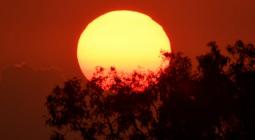Lethal levels of heat and humidity are gripping global ‘hot spots’ sooner than expected.

From the shores of the Persian Gulf to the foothills of Mexico’s Sierra Madre Occidental mountains, hot weather is reaching levels humans can’t endure. An analysis of 4 decades of data from thousands of weather stations shows that a handful of hot spots around the globe are experiencing a potentially lethal mix of heat and humidity—something most of these places weren’t expected to experience until midcentury.
“Previous studies projected that this would happen several decades from now, but this shows it’s happening right now,” says Colin Raymond, a postdoctoral researcher at NASA’s Jet Propulsion Laboratory who led the study.
Hot weather is already lethal. A 2003 heat wave, for example, killed more than 70,000 people in Europe, when outdoor temperatures reached more than 40°C. But it’s not just the heat that kills. Humidity is deadly when it prevents the evaporation of sweat—a remarkably efficient way for the human body to cool itself. To measure the effects of heat plus humidity, scientists use wet bulb temperatures—the lowest temperature to which air can be cooled via evaporation.
At wet bulb temperatures above 35°C, researchers estimate that even fit people will overheat and potentially die within 6 hours. Although that temperature might seem low, it equates to almost 45°C at 50% humidity, and what it would feel like 71°C using the U.S. National Weather Service heat index. In the heat wave that ravaged Europe, wet bulb temperatures hit 28°C.
Climate change will likely make these conditions more common in places such as southwest Asia, India, and China, researchers say. But their models estimate temperatures for relatively large swaths of land. Likewise, analyses of past weather data assess conditions over grids of more than 700 square kilometers, potentially missing localized spikes.
Raymond wondered whether that might obscure specific hot spots where geography and weather are already conspiring to create intolerable conditions. To find out, he and his colleagues combed through 39 years of hourly data from weather stations on six continents, dating back to 1979.
They discovered a handful of individual spots—including shorelines along the Persian Gulf and river valleys in India and Pakistan—had crossed the 35°C wet bulb threshold, though only for an hour or two at a time. And in 2017, wet bulb conditions topped 30°C 1000 times—more than double the number in 1979, they write today in Science Advances.
Weather stations in several other places stood out. They include Mexican towns near the Gulf of Mexico and the Gulf of California, and the coastal city of San Francisco in Venezuela. Areas in the Caribbean, West Africa, and southern China also had extreme readings. Weather stations in these places recorded approximately 1000 incidents registering at 31°C, while the wet bulb temperature broke 33°C about 80 times, according to the researchers.
Many of these hot spots, which can be seen in this interactive map, have already been flagged by models.
To guard against errors from malfunctioning weather stations, Raymond’s group compared the data with sea surface temperatures measured by satellites and air temperatures measured by weather balloons near the Persian Gulf, where the temperatures were highest.
Though previous work has analyzed temperature records, this new study adds insight by pairing temperature with humidity, says Noah Diffenbaugh, a Stanford University climate scientist who studies temperature extremes and was not involved in the research. The result is a detailed picture that’s “highly relevant for heat stress in humans,” he says.
And this kind of historical data adds more evidence of growing heat extremes predicted by models, says Elfatih Eltahir, a hydrologist and climate scientist at the Massachusetts Institute of Technology who forecasts extreme weather in Asia. It suggests the models might even be underestimating how soon these extremes will take hold. “In reality, maybe they are happening faster [than we think],” he says.
8 May 2020
Science





